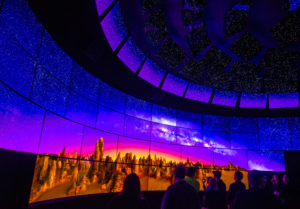
(Kobby Dagan/Shutterstock)
CES has evolved from its Consumer Electronics roots to being a far more complex show that is somewhat reminiscent of Comdex. This means that, often, the first appearance of a new technology that will initially or eventually move into the enterprise shows up at CES. (Unfortunately, the show comes at the beginning of January and messes up the holiday vacations of those that have to prepare for it.) This year, the AI announcements showcased a clear focus on improving productivity in areas ranging from the creation of automated factories, to the training and management of robotic fleets, to both graphics design and authoring.
Without mentioning the vendors, let’s talk about what some of these AI announcements will mean for our increasingly automated future.
AI As a Helper or Rival
One of the things we’ll have to wrap our arms around is whether AI will fully emerge as a technology that enhances or replaces us. At CES this year, most of the advanced AI technology I saw enhanced rather than replaced people. However, when you have severe labor shortages like our industry is weathering, there is a growing trend to move to replacement given there aren’t enough workers to enhance at the moment.
One of the areas getting the most focus is the food industry where the labor shortage is forcing stores to close for lack of staffing. In this industry, robots are more expensive to deploy than people, but if you can’t get the people, then the choice is whether you can even do business, and that could force a robotic replacement strategy. It is interesting to note that it is the fry station that is getting the most attention because, apparently, that is where the most injuries result.
End-to-end Virtualization in the Metaverse
Showcased at the event was the first end-to-end metaverse tool set that would help with the creation of the physical factory building, the design and layout of the manufacturing lines, the pre-training and simulation of the robotic manufacturing process, the design and training of AI-operated products, and the AI management of the entire facility and eventually the products it produces.
The metaverse is used to first conceptualize both the factory and the products it creates, test both in simulation so problems can be addressed before either is built, and then overlay a management utility that manages both separately, which minimizes labor and advances the broad use of AI significantly. It wouldn’t take a huge leap to imagine a future where a factory created and run by AIs builds new AIs without any human being involved in the process. In effect, we are seeing the beginning of a path to AI reproduction which could have interesting implications about our future.
AI-Generated Content
One of the demonstrations was the use of metaverse tools to create a shortform animated movie in real time during the pitch. A team of employees using a variety of interlinked creation tools created the characters, set, story line and finished product in about the same time it took me to write this paragraph, arguably making older approaches like story boards obsolete. Upscaling the result with future technology could result in a finished photorealistic product that allows a small team of individuals to create a movie that looks like it has live action but instead uses avatars that look like real people. From conception to finished product, the result would cost a tiny fraction of what a similar movie today would cost using animators and live actors. ChatGPT, an OpenAI offering, is already showcasing how songs, stories and even books can be created by AI. Tools to create professional-looking art from rough drawings from non-artists was another highlight of the initial announcements.
Finally, for broadcasters, improvements to how AI could enhance how you appear on screen were showcased effectively suggesting a time when you could appear on Zoom perfectly turned out even though you were actually in your PJs because you just got out of bed (not that this has ever happened to me).
Wrapping up:
CES continues to evolve from a Consumer Electronics event to one that covers a far broader use of technology, including in the enterprise. AI is now the most obvious demonstration of this change and shows us how future and ever more intelligent products will be conceived by AIs that will also conceive the related factories and design the production lines. AIs will even produce and evolve the products the factory makes over time, effectively introducing AI reproduction capabilities.
While most of what I saw at CES enhances rather than replaces people, there is a clear and growing trend to flip to replacement due to the severe labor shortages plaguing many industries. So, while this show is another step in the birth of general purpose AIs, it is also potentially the sunsetting of many existing jobs and employees.
CES was fascinating and just a little scary this year when it came to AI advancement. 
About the author: As President and Principal Analyst of the Enderle Group, Rob Enderle provides regional and global companies with guidance in how to create credible dialogue with the market, target customer needs, create new business opportunities, anticipate technology changes, select vendors and products, and practice zero dollar marketing. For over 20 years Rob has worked for and with companies like Microsoft, HP, IBM, Dell, Toshiba, Gateway, Sony, USAA, Texas Instruments, AMD, Intel, Credit Suisse First Boston, ROLM, and Siemens.
Related Items:
AI Expected to Make Big Splash at CES 2023
In the Shadow of the Twitter Acquisition-Layoff Disaster: How to Prepare for Layoffs
The Need to Refocus AI Priorities

